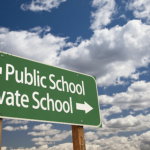Perspectives is an opportunity for Fellows and others to share their ideas in short, accessible essays. IPE/BC Fellows hold a range of views and interests relative to public education.
NATO’s 2% and public school funding
by John Malcolmson
July 17, 2024
It is hard to turn on the TV these days without being besieged by news of Canada’s “failure” to meet a “2% of GDP” defense spending target. We are all invited to share in the shame of this failure. Canada the laggard, the freeloader, the scofflaw! Busy spending money on other things while ignoring important international commitments!
By my “back of the spreadsheet” calculations, moving Canada to 2% of GDP on defence would have us spending about $14 billion more each year going forward. And yes, that is not a typo – it is billions we are talking about.
 The NATO-induced commitment is not something prescribed by law. Nor is it a treaty commitment. It is a political deal hashed out within a supranational military organization that hasn’t been elected by anyone. It is very telling that when the Prime Minister announced his recent 2% timetable, it was not done in parliament, or even within Canada – it was done in a European forum in front of politicians, bureaucrats, generals and defense pundits – and covered by a mainstream media that increasingly functions as echo chamber for military-industrial interests. This is the group calling the defense spending shots and the group Canada has decided to answer to.
The NATO-induced commitment is not something prescribed by law. Nor is it a treaty commitment. It is a political deal hashed out within a supranational military organization that hasn’t been elected by anyone. It is very telling that when the Prime Minister announced his recent 2% timetable, it was not done in parliament, or even within Canada – it was done in a European forum in front of politicians, bureaucrats, generals and defense pundits – and covered by a mainstream media that increasingly functions as echo chamber for military-industrial interests. This is the group calling the defense spending shots and the group Canada has decided to answer to.
What if, instead, we agreed to commit 2% of our economy to running our public school system? Not too long ago (2013) BC did spend the equivalent of this amount on school operations but those days are now in the rearview mirror. IPE has done past research on this very question and recently sent a letter to BC’s Premier touching on this topic
Currently we spend in the order of 1.6% of GPP (Gross Provincial Product) to run our public schools. Increasing it to 2% would pump an additional $1.67 billion into the K-12 system annually.
Admittedly, comparing defense and school spending has some challenges. Defense is a federal responsibility while public education is provincial. NATO spending plans include capital outlays while our suggested focus on public education funding is limited to operating expenses. And is the idea of linking school funding to GPP the best option for us to consider when looking at how we support public education?
All this aside, the idea that we must spend more on defense while holding current financial rations in place for schools raises other important issues. Decades of neoliberal globalization have left Canadian industry and society ill-equipped to benefit from boosted defense spending. Case in point: plans for Canada to partner with other countries to acquire a new submarine fleet. The lion’s share of the billions to be spent there will go offshore once decisions are finalized. Foreign military contractors like Boeing, McDonnell Douglas, General Dynamics and Raytheon wait in the wings, salivating at the prospect of such new largesse. And little in the way of spinoff benefits for Canadians.
Compare that with a public school system which pushes spending on wages, salaries, services and supplies into every single BC community, large or small. And think of what we might do with an additional $1.67 billion in school funding every year:
- Pay teachers, support staff and others’ wages and salaries that would make careers in public education a more attractive option,
- Address the longer-term sustainability of our public system, including things like mentoring and supporting new staff currently at increased threat of burnout,
- Have smaller classes, something research confirms are better able to deal with complex student needs
- Overhaul and fund a special education system straining under the impact of decades-long neglect,
- Expand and improve professional development to ensure all staff are better equipped to deal with complex and changing needs of both students and the school system as a whole,
- Accelerate necessary repair and maintenance on existing facilities so that, among other things, older school buildings aren’t death traps when a major seismic event eventually happens,
- Ensure all schools have the best technological resources at their disposal, those able to support valued educational practices,
- Look at possibilities for better integrating schools into local and community networks providing other services (like childcare) to children and families,
- Other? (Fill in your priority – ‘hopes and dreams’ encouraged) _____________________
Here’s a radical idea – encourage and support experimentation and innovation aimed at making schools better able to deal with the social and educational challenges of the future.
Or maybe something more modest? How about moving the public school system off the treadmill of endless triage caused by  resource shortage and funding insecurity?
resource shortage and funding insecurity?
Funding decisions are about the priorities we make for how we want to live. And we would be wise to remember money spent in one area is not available in another.
Do we want to steer money to funding a military alliance whose recent history is one of fueling war, conflict and tension in distant places around the globe? Or do we want to support and improve a vital public institution, and ensure its sustainability for the generations to come?
John D. Malcolmson, Ph.D, is an IPE/BC board member and a consulting sociologist providing research advice to unions on matters relating to compensation.


